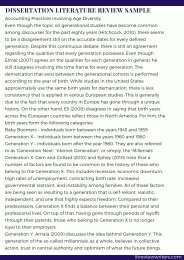Thesis Literature Review Sample
Hi! Just take a look at this professional thesis literature review sample and find out how it need to look like. http://www.litreviewwriters.com/thesis-review-help/
Hi! Just take a look at this professional thesis literature review sample and find out how it need to look like. http://www.litreviewwriters.com/thesis-review-help/
Create successful ePaper yourself
Turn your PDF publications into a flip-book with our unique Google optimized e-Paper software.
THESIS LITERATURE REVIEW SAMPLE<br />
The Aspiration of the Various Languages of the World<br />
Pronunciation refers to the production of sounds in order to convey code<br />
or meanings. It requires more attention towards the specific sounds of a<br />
language, voice quality, aspects of speech, and others. It is considered as<br />
a highly important aspect in our communication. In order to reach a<br />
better encoding of sounds in speech, it is important to use a standard<br />
pronunciation. It also helps listeners in easily decoding the message.<br />
However, because of the various factors involved, there may be various<br />
pronunciations in a single language. The difference in pronunciation<br />
creates various accents in the language. For example, English has more<br />
accents compared to other languages. Since it is also considered as a<br />
global language, it has become a requirement to have the capacity to<br />
communicate in the English language for each nation in order to survive<br />
in this world. Therefore, there are a lot of accents just in the English<br />
language, as used by the different people who are using it, either as their<br />
first or a second language.<br />
The study involving aspiration plays a very important role in phonology<br />
studies. There are different interpretations as to what the concept of<br />
aspiration is. Lendl (1995) defines aspiration as a process with which right<br />
after the lips are opened for uttering a sound for a consonant, there is<br />
silence for a short period of time. Just a little breathing sound going out of<br />
the mouth may be heard at this time. This is what aspiration means.<br />
In pronouncing the letters /p/, /t/ and /k/, there is a certain delay before<br />
the start of the next sound. With this delay, the air flows like a puffing with<br />
a sound of air discharging (Kent, 2001). Therefore, aspiration is almost<br />
always accompanied by this delay in airflow and as such, aspirated sound<br />
refers to the sound that is produced while discharging the air in this<br />
delay. In this period of delay of sound creation and air flow as air is<br />
discharged, our articulatory organs need to put more force when it comes<br />
to moving out air compared to pronouncing other usual sounds. Yale<br />
(2008) also describes is phenomenon, saying that in the aspirated sound<br />
for the letters /p/, /t/, /k/, the sounds that the muscles need to put more<br />
force in pronouncing them. They also require a higher level of pressure<br />
coming from the oral organs as we release air in order to pronounce<br />
them, putting more effort in releasing breath.<br />
litreviewwriters.com
THESIS LITERATURE REVIEW SAMPLE<br />
Aspiration is not just the phenomenon related to the pronunciation of<br />
one sound, but involves other factors. One is that aspiration is typically<br />
present in those voiceless sounds, given that the voiceless sounds also<br />
follow a voiced sound. Another is that aspirated sound usually happens in<br />
the initial part of a syllable. The first sound, the one which is voiceless, is<br />
aspirated always (Lendl, 1995).<br />
Another factor is that the preceding sound of the sound that is aspirated<br />
is half lost and delayed. Mostly, a delay of 30-40 milliseconds, while the<br />
preceding sound ends up being shorter than usual. With this delay, some<br />
whispering sounds results to voicelessness. Also, while pronouncing the<br />
first voiceless sound that the articulators take in form of the second<br />
sound, being ready to pronounce it. The sound created in this delay for<br />
the articulators is known as aspiration. This is because of the adaptation<br />
of the specific shape by the articulators for becoming ready in<br />
pronouncing the second voiced segment in between a segment that is<br />
voiceless and a voiced segment that followed can be heard.<br />
References<br />
Kent, H. (2001). Teaching, Learning and Speaking English as a Foreign<br />
Language. USA: Michigan University Press.<br />
Lendl, T. (1995). Aspiration and voicing in language stops. Journal of<br />
Accent and Phonetics, 34(2), 45-56.<br />
Yale, W. (2008). Principles in Phonetics (3rd edition). Cambridge Press.<br />
litreviewwriters.com






